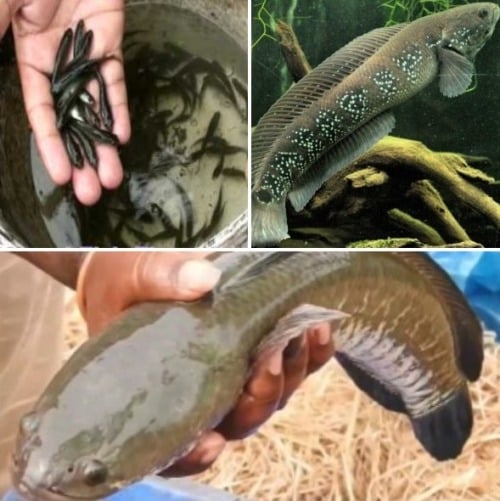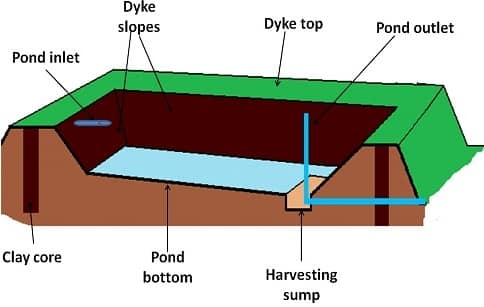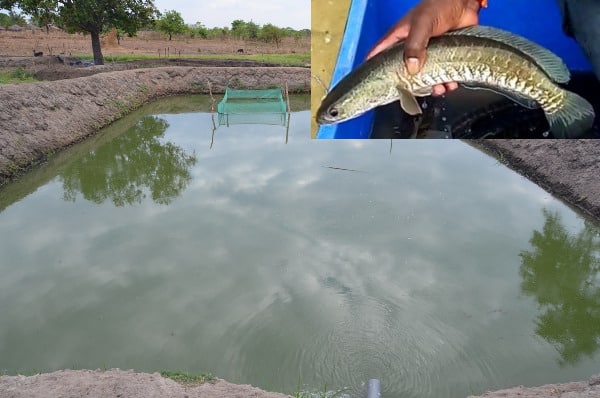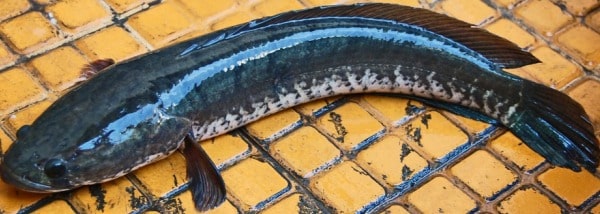MURREL FISH FARMING PROJECT REPORT
The following information is about Murrel Fish Farming Project Report.
MURREL FISH FARMING PROJECT REPORT – INTRODUCTION TO MURREL FISH:
Murrel belongs to the snakehead fish species. It is believed to be the native of the south and Southeast Asia. The binomial name of Murrel fish is ‘Channa Striata’. The maximum length of this fish is considered to be one meter, but since it is a fishing variety this length is hardly available. It weighs around 2 kg. This fish is identified by its dark brown color with light black stripes over the body. They are well noted for their air-breathing method. They have elongated bodies which are anteriorly cylindrical and posteriorly compressed. This fish is commonly found in fresh water plains, but migrates to flooded fields and returns back to water bodies in the dry season, where it burrows itself in the mud for survival. Kerala and Bengal are well known for preparing varieties of dishes with the Murrel fish. This fish is considered famous in Telangana for it being used as a medicine for asthma patients. These fish are expected to be rich in iron and amino acid content.
This snakehead variety is addressed depending on the location such as Nga-mu in Meitei; shol is Bengal, sheula in Orissa, viral in Kerala, selumural in Tamilnadu, korramenu in Andhra Pradesh, Lula in Srilanka, treyross or pla chon in Thailand, gabus in Indonesia, haruan in Malaysia, haloan or mudfish or dalag or halwan in Philippines.
‘Freshwater aquaculture’ is an economy generating and rural development tool. Murrels are considered to be the most economical freshwater fish species which can be cultured. The idea of Murrel farming began in Thailand, the Philippines and Taiwan. In India, Murrel fish farming developed four decades ago and was first implemented in Sunkesula fish farm (AP) by the state fishery unit. Initially, Murrel culture was not very successful owing to the mortality rate of the fish due to the epizootic ulcerative syndrome. Later on ‘The Centre for Aquaculture Research and Extension (CARE)’ financially aided by ‘The Department of Science and Technology’ developed a technology package for the culture of Murrel species. This package deals with all the necessary requirements for Murrel culture and also provides training to the rural population on the commercial culture of Murrels.
Andhra Pradesh is the second largest fish farming region in the country with 0.8million hectares of inland water bodies producing 1.24 million tonnes annually. There are eight varieties of Murrels found in the country, but only four are cultured. They are Channa Striatus, Channa Marulius, Channa Punctatus and Channa Gatchua.

LAND REQUIREMENTS FOR MURREL FISH FARMING PROJECT REPORT:
Land selection for fish farming is an important criterion as this determines the success rate. The fertility of the soil and the water retention capacity are the two factors which determine the influence of fertilizers on the fish farms. Ponds at higher elevations should be capable of self-draining. The land chosen should have a good supply of water round year and should be free from industrial wastes, harmful substances, and other domestic pollutants. The soil of the land should bind itself naturally. There should be the availability of groundwater and the permeability level should be medium. The land for fish farming should not have a high concentration of roots and organic substances. The land for fish farms should be chosen such that it is far away from the flood area.
Read: GM Crops Advantages.
MURREL FISH FARMING PROJECT REPORT – POND CONSTRUCTION:
The size of the pond for fish farming is an essential factor because it determines the quantity of Murrel fish that can be raised efficiently and deliver higher productivity. The earth that is excavated from the area is used in constructing the dyke. There is a systematic way to construct a pond. Initially, all the garbage of a chosen land is cleared out. A dyke which is free of seepage issues and is highly secure is constructed using clay core. The pond is dug and the inlet and outlet are designed. Soil and plant grass is used to cover the dyke. Proper fencing is organized to protect the pond from animals and theft. While constructing the pond 30cms of surface soil has to be removed.
Dyke specifications for Fish Farming Project Report:
The constituents required for dyke construction are 15-30% silt, 45-55% sand, and 30-35% clay. A stable slope depends on the width of the berm which should be approximately one meter. The horizontal to vertical ratio of an embankment slope is proposed to be 2:1 for clay soil and 3:1 for silty, loamy or sandy soils. For the dyke to be raised the clay mixture is deposited as a thick layer (10-15 cm’s) in the center of the pond. An extra outlet is provided on the embankment to avoid damage due to the excess water level in the pond. Creeping grass is grown over the dyke to reduce soil erosion. The embankment slopes are planted with elephant grass gunny grass and Napier grass as a source of food for the carps in the pond.

Pond specifications for Murrel Fish Farming Project Report:
for every stage of the fish development, the requirement of the pond changes. Usually, the dimension of a pond is rectangular in the ratio of 3:1 (length: breadth) for easy harvest. As per the specifications, the maximum width of the pond should not be more than 30-50m. The total fish farming area is divided into different categories depending on the processes involved. 5% of the farm is allotted to the nursery, 20% to rearing pond, 70% to stocking pond and 5% of the treatment of the pond. The general construction of a pond is such that the high altitude area is for the nursery next to the rearing and the lowest is the stocking pond. This helps in easy farm management.
- ‘The nursery pond’ is 0.01-0.05 ha with a depth of 1-1.5 m. This is the stocking place for spawns, which are three days old and are reared here for 30 days to grow 2-3cm in length.
- ‘The rearing tank’ is a place where fry fish are reared into fingerlings of length 10-15 cm. The process takes 2-3 months and the size of the pond is 0.05-0.1 ha with a depth of 1.5 – 2 meters.
- ‘The stocking pond’ is 1- 2 ha with a depth of 2.5 – 3 meters. This is a place where fingerlings are reared to original marketable size. The growth of fingerlings takes around 8-10 months.
- ‘The treatment pond’ is also called bio pond. Here the water is treated biologically. The bottom of the tank is made even and flat so that the netting becomes easy. These are large enough for stocking and settling of produce.
- The construction of the pond is of two types; The Dugout and the Embankment. The construction of dugout pond is scientific in nature which considers factors like size and depth during construction. This is generally suitable in the plains. The other variety is suitable for hilly areas but is not an ideal type for fish farming because scientific parameters cannot be included while construction.
- ‘Pond fencing’ is done to protect the fish farms from external animals and theft.

MURREL FISH FARMING PROJECT REPORT – SEED COLLECTION FOR MURREL FISH FARMING:
Wherever there is high aquatic weed vegetation such as rain-fed water bodies Murrels breed there throughout the year. The seeds move in the water to feed and are noticeable due to the ripple generation. As the seeds move in shoals, the entire shoal is collected using a meshed net. Fingerlings of this species are obtained from rivers, tanks, and reservoirs. The seed of Murrels is available from May till August and commercial culture is not practiced due to nonavailability of adequate quantity of seeds. Murrel seeds are generally obtained from natural places and sold to farmers who stock them with other aquaculture species. This kind of stocking helps in removing weed fishes and also provides extra income to the farmers.
MURREL FISH FARMING PROJECT REPORT – DRAINAGE AND WATER SUPPLY REQUIREMENTS FOR MURREL FISH FARMING:
Building fish farms require sufficient water supply because at regular intervals the water level in the ponds has to be adjusted. Naturally occurring water bodies have stable parameters like temperature, pH, hardness and dissolved oxygen content. Water should neither be acidic nor alkaline, it should be neutral. Organic materials are added to bring water to a neutral state in case of disturbance. The dimensions of the water inlet pipe for the farm should be such that it takes not more than 1 or 2 days to fill the pond. The outlet pipe is provided at the bottom of the farm to remove water during harvesting or to exchange water from the pond to maintain its quality.
Read: Practices of Natural Farming.
A feeder canal regulates the water supply to the pond. The water that is pumped into the farm is filtered using screens to avoid unwanted particles. Sluice gate with wooden shutters at the entry and exit is placed at 30 cm above the farm. The use of sluice gate is to drain water into the feeder canal, help desalination and aid in water exchange. The ideal temperature of the water on the farm is 20-30 degree Celsius. Controlling the temperature is highly essential for optimum growth and maximum produce.
MURREL FISH FARMING PROJECT REPORT – BROOD FISH FOR MURREL FISH FARMING
Brood fish are stocked in the rectangular ponds with dimensions 6mx 5m x 1m with a stock density of approximately 10,000/ha. The fish food organisms are obtained by adding manure @ 5000 kg/ha/yr and lime @ 300kg/ha/yr to the pond. The nutrition and quantity of feed are essential factors for breeding. A suggested diet for the brood fish is 70% protein in the form of the chicken intestine, 5% protein in the form of fish waste and 63% protein in the form of the beef liver such that the rate of spawning is 6000 eggs and the fertility rate is 90%. There is a possibility of inbreeding depression due to the same type of brood fish. So, new fish from rivers and streams are introduced into farms every year. The quantity of feed is 2-3% of the weight of the fish. The quantity of the feed changes to 3-4% of the weight when the density of fish is high in the pond. The brood fish are examined regularly for maturity. Water in the stock pond is replaced every week to maintain the quality of the water. The sex of the fish is determined during the spawning period when the female fish has a soft bulged abdomen with the developed ovary and reddish oval genital pore. The male fish is characterized by small genital papilla and a round head.
MURREL FISH BREEDING METHODS
Natural and induced breeding are the two common varieties of breeding in Murrels.
Natural brood fish size is 100-250 grams stocked in a small pond. They breed in a natural environment by building a nest with aquatic weeds. The eggs laid in the nest are taken to the hatchery for rearing and the response of breeding is very low about 20-30%.
A pond with a depth 40-80cm filled with one-fifth of aquatic weed (water hyacinth) is prepared for the simulation of breeding. A synthetic hormone, ovaprim is recommended @ 0.5ml/kg by the CARE team. One breeding set consists of a single female and two male fish which after the hormone injection is introduced into the breeding tank. Ana alternate natural hormone human chorionic gonadotropin (HCG) @ 20-30mg/kg of male and 30-40mg/kg of a female can also be used instead of ovaprim. Monsoon is considered the best season for induced breeding.
The spawning takes place after 6 to 10 hours of ovaprim injection. The mass of 5000-10000 eggs is 6-14 cm in diameter the fertilization rate is 70-90%. Eggs hatch after 24-30 hrs from fertilization to produce 2.8-3.2 mm length of tiny fish. Each spawning produces 4000-8000 female fish.
With HCG the fertilization rate is 80-98%. The spawning takes place 16-18 hrs after injection and the eggs released are 10000 to 15000 by a 1kg female fish. The hatched fish are 3-3.5 mm in size.
PRODUCTION AND REARING OF FRY AND FINGERLING
After hatching, the yolk sac is absorbed within 1-3 days and the development of the digestive tract takes place. At this stage, it feeds on small planktons like rotifers and protozoans. Here they grow to 20-30 mm size and they survive @50-60% /25 days. The survival of fry fish is affected by two factors; one is heterogeneity which is caused by improper food distribution and less space for the fry in the pond. Cannibalism directly affects heterogeneity and is avoided by providing a high feeding rate. 40—50% protein is offered to the fry fish upon the development of the digestive tract. The survival rate is increased by addressing the food and intake behavior of the fish.
Fingerling Fish growth is hampered by not observing the stocking density. 20000-460000 ha/yr is the stocking rate in Murrels. When the stock density is 15000/ha it produces a survival rate of 76.67%. The fingerlings feed on crustaceans, earthworms, and tubifex. The floating feed has to be given to reduce the cost of operation. The quantity of feed has to be increased as long as cannibalism continues. The fingerlings need 40-45% protein and the survival rate is 30-40%
Grow out fish have to be protected by the steep dyke construction. Lack of oxygen in the water tends to bring the fish to the surface, thereby due to an increase in energy, the growth is affected. They consume insects. The stock size of this fish is 10g. The fish grows at the rate of 600-800 g each year. Production range is 2-2.5 tons/ha/yr. The rearing of the Murrels should be done such that the same sized Murrels are put together otherwise there is a high risk of cannibalism.
Murrel culture is being popularized among fish farmers using earthen ponds by the CARE group. Earthen ponds are built and are filled with 25cm of clay at the bottom. Water is filled to a height of 1m and fingerlings of the same size (length 8-10cm; weight 5-12g) are reared in the pond by providing an adequate feed of boiled chicken intestine which is 5-10% of their body weight. Borewells are used to supply water to the ponds in case of seepage and evaporation issues. The entire water in the pond is replaced once in 3-4 months and the Murrels are inspected for any infections. After thorough sorting, the Murrels are released back to the pond filled with fresh water. Murrels attain a weight of 800-900g within 8 months of culture. Using this CARE technology method the farmers can earn good income without depending on seeds from the wild.
Harvesting of Murrels is done in the summer season using scoop and hand nets. Before harvesting the pond is drained.
Read: India Agro Based Industries.
ADVANTAGES OF MURREL FISH FARMING:
With the synthetic hormone technology breeding in Murrel fish is practically possible during any time of the year. The quality of the fingerlings produced is high, thereby the quality of Murrels is also high. This technology aided Murrel culture provides employment to the youth and becomes a source of income for rural households. The method of artificial propagation during the broodstock rearing helps conserve certain threatened species of Murrels.
ECONOMIC SURVEY AND BUDGET REQUIREMENTS FOR MURREL FISH FARMING:

The Centre for Aquaculture and Research Extension (CARE) proposes that an area of 600-700 square meters can generate an income of 50000-70000 annually through Murrel fish farming. The budget is estimated as:
A pond size of dimensions 15mx10mx1m consisting of 5 ponds can generate an income of 43000 in 10 months and 66000 every subsequent year, with total expenses being 53000 (excavation @ Rs 5000/pond, bamboo fencing @ Rs 1000/ponds, net @ 1000/pond, cost of fingerlings @ Rs 1/ fingerling, feed cost @ Rs 20000/10months and other costs @ Rs 2000/ 10 months). Similarly, a fish farm with dimensions 25m x12m x1m with 2 ponds can generate a net income of Rs 33000 after 10months and an income of Rs 56000 for every subsequent year where the expenses are estimated at Rs 47000.
ATTENTION TO THE EUS INFECTION FOR EFFECTIVE MURREL FISH FARMING:
The epizootic Ulcerative Syndrome (EUS) is the main cause of the high mortality rate in Murrels each year. The Channa Striatus and Channa Marulius are the most affected. The infection occurrence is higher in younger Murrels but all sizes of Murrels are susceptible to this. Frequent surfing is a distinct behavior exhibited by Murrels with marked ulcerative lesions. Red colored lesions indicate the start of an infection. They gradually enlarge and spread while becoming deep and take the form of an ulcer. During further stages, the scales fall off and necrotic ulcerative lesions occur at the base of the fins and from the entire body. The fish rot and die eventually.
As a solution to this problem addition of lime @ 100-600 kg/ha and KMnO4 @ 1-10mg/l is suggested. Also, prophylactic treatment is suggested where CaO is applied @ 50 kg/ha and a week later bleaching powder@ 0.5ml/l is applied.
Read: Biofloc Fish Farming.
PROSPECTS AND FUTURE OF MURREL FISH FARMING:
Andhra Pradesh has many freshwater resources, but the area used for the farming of Murrels is very less. The construction of reservoirs and projects on major rivers in the AP leaves the nearby land logged with water which becomes unproductive for agriculture. In such instances, these lands can be used effectively for the construction of fisheries and Murrel farming. The commercial Murrel fish farming can be undertaken by the use of technology and the resources available. There is a high domestic demand for the Murrel in the state which promises better results. Also in a tropical country like India, where the dissolved oxygen content in water is low, the aquaculture of air-breathing Morris is highly advantageous as they can resist this environment. The central institute if freshwater aquaculture, an organ of ‘The Indian Council of Agricultural Research’ has found out methods for natural breeding in Murrel fish farming project report. Concrete tanks are used for producing seeds and breeding Murrels. Development of a breeding technology, which provides hatchery conditions will make a difference in fish farming. Further research has to be done to understand the demands of Murrel nutrition and breeding so that it can help in the commercial farming of Murrels. Murrel farming can increase employment opportunities among the rural youth and is considered as the best alternative source of aquaculture besides catfish and carp.
Looking to start fish farming in Hyderabad need project report
Which fish Farming?
I am looking full project report of murrell farming in biofloc tank system.
I am looking full project report of fish farming.rohu,katla, sawal.
We will update soon.
Hello Mr.Agrifarming,
I having plan to start murrel fish farming in coimbatore,may you please guide me. send your contact number. i need a project report and your help.
Want to start “Desi Magur” fish farming at West Bengal in a 10 Decimel Land / pond. Need Project Report for the same. Please help.
Read this: >Raising Catfish In Tanks, Ponds.
I am just thinking to start a murrelet farm .the size of the pond approximately 20feetx70feet can u give details like the depth,construction of the pond,how many fingerlings I can grow,feed cost for a year and so
Is it possible to do murrel culture through Biofloc? If yes please provide a source along with project report if available…. Thanks in advance.
Required DESI MANGOR FISH SEED 75,000 Nos.
If possible your fish farm house
Can you please let me know, if we can carryout murral fish farming in Mahabaleshwar (Maharashtra)? weather is moderate cold here.
can u please give brief information of MURREL fish farming and how “government of telangana”helps in setting up the pond by providing subsidies ?
Looking to start fish farming in Nalgonda
Our family is having 90 acres of private deed land in Trincomalee, Sri Lanka. I need a good and sound financial partner to develop a snakehead farm on equal partner-ship.
Hi,
Any one in telanga karimnagar to train on murrel famring and pond preparation
Please advise
What is to feed for murrel after egg, fry time.
U wish to start Fish Farming and hope agrifarming would help me in this regards